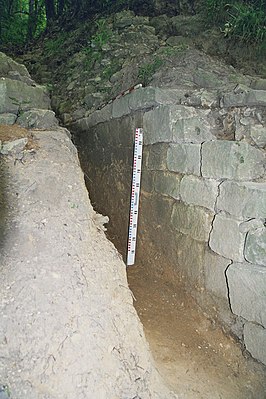Alt-Scharfeneck Castle
| Alt-Scharfeneck | ||
|---|---|---|
|
Excavated in 2007 by G. and J. Decker |
||
| Alternative name (s): | Frankenburg | |
| Creation time : | around 1100–1130 | |
| Castle type : | Höhenburg, spur location | |
| Conservation status: | Wall remains | |
| Standing position : | Ministeriale | |
| Place: | Frankweiler | |
| Geographical location | 49 ° 14 '7 " N , 8 ° 3' 7" E | |
| Height: | 363 m above sea level NN | |
|
|
||
The Alt-Scharfeneck Castle was a late medieval Spur castle . The beginnings of the castle go back to the time of the Salians (1024–1125). It is located in the municipality of Frankweiler in the Südliche Weinstrasse district in Rhineland-Palatinate .
location
The few remains of Alt-Scharfeneck Castle are on a 363 m high mountain spur at the northeast end of the Ringelsberg above the entrance to the Hainbachtal in the southern Palatinate Forest . The time of origin was around 1100-1130 and most likely a class position . In today's maps, the area is only shown as an "artificial embankment ".
history
The castle was probably built during the time of the Salian emperors in the first third of the 12th century. The knowledge gained during the excavations carried out by Gottfried Decker Frankweiler allows a dating to the time of the Salians. This contradicts earlier assumptions that the castle was built by order of Emperor Friedrich Barbarossa to protect the Trifels and that it was owned by Heinrich I "the old" von Scharfeneck in 1219 , who named himself after the castle. The following owners were his two sons Heinrich "the Elder" and Heinrich "the Younger" in 1232 . Almost two hundred years later, in 1416, the castle is said to have been left to decay, as it was completely moved to the new Neuscharfeneck Castle . It was not until the 1950s that further foundation walls were rediscovered during excavations . It was possible to uncover three different remains of the wall, the outer shells of which consist of small-square masonry typical of the Salier period. The fact that a remnant of the wall was built with clay instead of mortar also points to the Salier period. (Comparable masonry on the Trifels, Anebos and on the Schlößel near Klingenmünster.) The discovery of Wiligartaburg and similar ceramics allow construction to start earlier than previously assumed. Of course, these findings do not exclude the fact that the von Scharfenberg / Scharfeneck owned the castle at their time. It is very likely that the castle was abandoned and left to decay before the end of the 14th century. In 1830, the ancestors of the current owners - the castle grounds are privately owned - brought the ashlars of what was probably the remains of the northern enclosure wall and the remains of a flanking tower to the fortress construction in Germersheim . It was not until the 1950s and then from the 1970s until today that some remains of the foundation wall were uncovered again through excavations by Kurt Müller and Gottfried Decker.
investment
There is no reliable knowledge about the building history and the appearance of the castle complex. The castle site is freely accessible.
Individual evidence
- ^ Article by Gottfried Decker "Alt-Scharfeneck" in the district of Südliche Weinstrasse: "Heimat-Jahrbuch 2007", page 129, ISBN 978-3-87022-326-7
- ↑ State Office for Surveying and Basic Geographic Information Rhineland-Palatinate: Neustand an der Weinstrasse, Maikamm, Edenkoben, Landau in der Pfalz , Topographic Map 1: 25000, 7th edition 2006, ISBN 3-89637-285-8
- ↑ a b Gottfried Decker: Alt- Scharfeneck . In: District of Südliche Weinstrasse (Ed.): Heimat-Jahrbuch 2007 . ISBN 978-3-87022-326-7 , p. 129.
- ↑ Arndt Hartung: Palatinate castle district . 6th edition. 1975, ISBN 3-9801043-0-3 .
- ^ Günter Stein : Burgen und Schlösser in der Pfalz , 1976, ISBN 3-426-04405-6 .
- ^ Müller 1957 / Stadtarchiv Landau / Pfalz
literature
- Jürgen Keddigkeit (Ed.): Palatinate Castle Lexicon. Part 1. A - E . on behalf of the Institute for Palatinate History and Folklore. Kaiserslautern 1999, ISBN 3-927754-18-8
- Alexander Thon, Rolf Übel : Palatinate Castle Lexicon. Part 1. A - E . On behalf of the Institute for Palatinate History and Folklore Kaiserslautern, 3rd revised edition 2007, ISBN 3-927754-61-7
- Article by Gottfried Decker "Alt- Scharfeneck" in the district of Südliche Weinstrasse: "Heimat-Jahrbuch 2007", page 129, ISBN 978-3-87022-326-7 , ISSN 0177-8684 ; see yearbooks of the district of Südliche Weinstrasse ( Memento from February 21, 2014 in the Internet Archive )
- Müller 1957 / City Archives Landau / Pfalz

